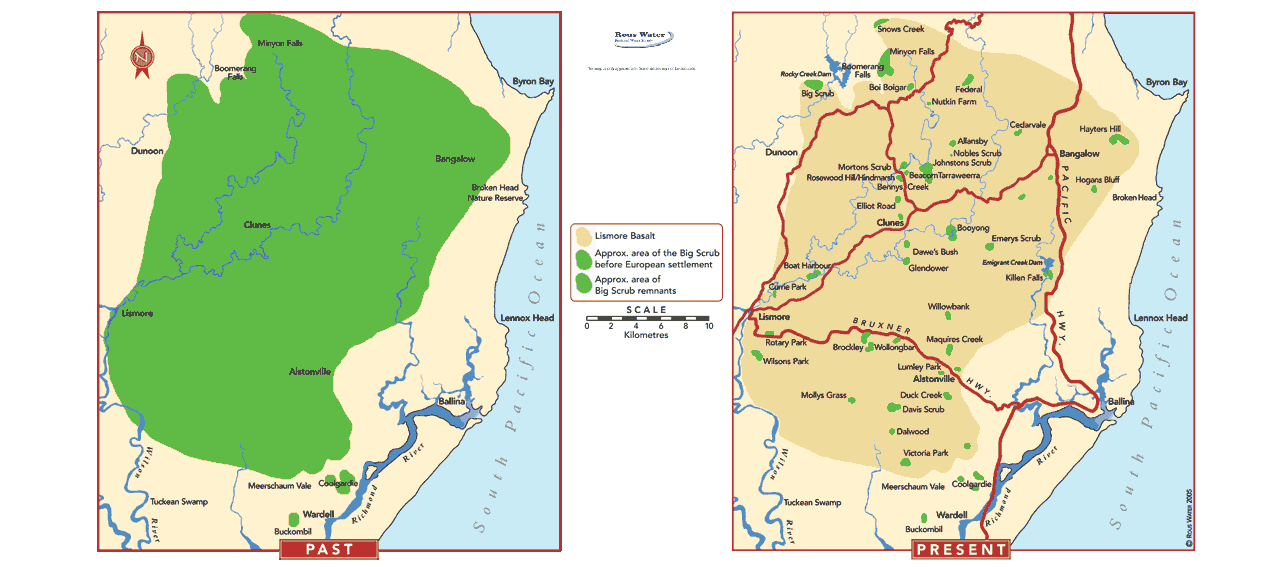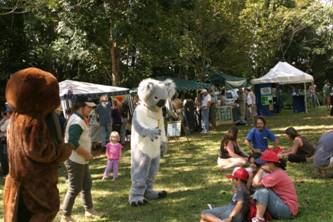Rocky Creek Dam
The area contains 148ha of rainforest, a high diversity of native trees and shrubs (181 species), wet forest birds (forty-five species, of which twenty-four are rainforest dependent) and other native vertebrates (twenty-five species, of which four are rainforest dependent mammals, one is a rainforest dependent frog and three are rainforest dependent reptiles), twelve plant species nationally listed as rare, vulnerable or endangered or have been recently recommended for listing as rare and thirteen vulnerable and rare species of fauna listed in Part Two of Schedule Twelve of the New South Wales National Parks and Wildlife Act 1974.
Rocky Creek Dam was constructed between 1950 and 1953 and is the main water supply for many local areas located throughout the Far North Coast of NSW, including Lismore, Ballina, Byron and Richmond Valley. The dam is situated within the Richmond River catchment, approximately 25 kilometres north of Lismore and is located along the southern edge of Nightcap National Park. Rocky Creek Dam can be accessed by bitumen road from Lismore, via Rocky Creek Dam Road. On-site access to the dam is provided via an existing bitumen road from the picnic area. Rocky Creek catchment is located within the Mount Warning Caldera region.
As a result of the fertile volcanic soils and high rainfall, the catchment is an area of high native flora and fauna species richness and endemism. The National Parks and Wildlife Service and NSW Fisheries indicate that the Terania Creek system, of which Rocky Creek is a tributary, has high conservation value.
The dam wall is 27 metres high, 187 metres above sea level and the dam when full, holds 14000 megalitres of water. The 29 square kilometres of catchment area includes sections of Nightcap National Park, Whian Whian State Forest and revegetated farmland. The runoff produces a very soft clear water for distribution to consumers.
The dam has a platypus viewing platform, elevated boardwalk and pontoon bridge, picnic, BBQ facilities with wood supplied, benches, tables and children’s play equipment.
Three walks are available: 10-minute easy walk, dam and spillway, a 15 minute reasonably easy walk to Pontoon Bridge, spillway & dam, a 40 to 60-minute big scrub bush walk with the possibility of getting wet.
The loop drive connects with a number of walking tracks of varying lengths (400m to 9km). These will take you deeper into the different types of forest and through rainforest gullies and along creeks. Some of the walks have views of the Rocky Creek Dam, lowland rainforest, waterfalls, Mt Warning / Wollumbin and the escarpment of the Tweed Valley.
Click here for more information about activities at Rocky Creek Dam.
Big Scrub Flora Reserve
The Big Scrub Flora Reserve area contains covers an area of 196 hectares and contains 148 hectares of rainforest, a high diversity of native trees and shrubs (181 species), wet forest birds (forty-five species, of which twenty-four are rainforest dependent) and other native vertebrates (twenty-five species, of which four are rainforest dependent mammals, one is a rainforest dependent frog and three are rainforest dependent reptiles), twelve plant species nationally listed as rare, vulnerable or endangered or have been recently recommended for listing as rare and thirteen vulnerable and rare species of fauna listed in Part Two of Schedule Twelve of the New South Wales National Parks and Wildlife Act 1974.
Big Scrub Loop Walk (1.5 km) This walk is a unique opportunity to view and experience the largest remaining area of the Big Scrub lowland subtropical rainforest. Originally covering more than 75,000 ha, the Big Scrub was the largest continuous area of lowland subtropical rainforest in Australia. Only a few hundred hectares remain as upwards of 99.7% of the rainforest on these deep red soils was cleared for agriculture.
Scrub Turkey Walk (3km back to Rocky Creek Dam Picnic Area) [This track is also known as the Northern Boundary Trail] This walk takes you through tall regrowth Flooded Gum (Eucalyptus grandis) and Tallowwood (Eucalyptus microcorys) forest, magnificent ‘old-growth’ eucalypt forest, and the lowland subtropical rainforest of the Big Scrub. The final kilometre of the walk passes through the Rous Water rainforest regeneration area, and across the spillway and dam wall to the picnic area.
Car and bus parking available.




